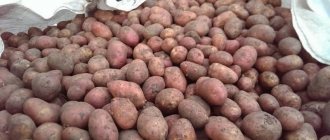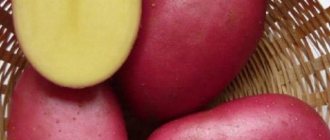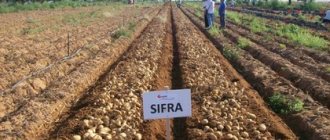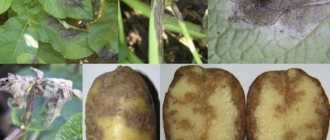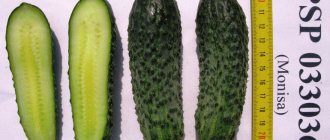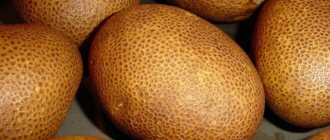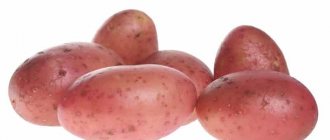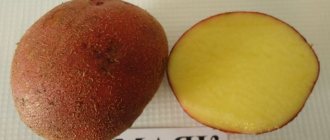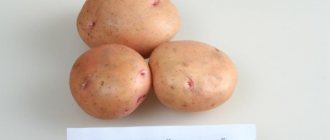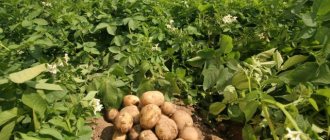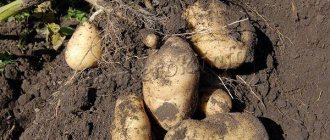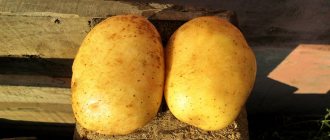Irbitsky potato is a type of crop obtained by Ural breeders of the research center, which is located in Yekaterinburg. In 2008, an application was submitted to conduct tests confirming its characteristics. The Irbitsky variety was included in the State Register in 2012 and is recommended for cultivation in the Volga-Vyatka and West Siberian regions. The variety has gained wide popularity due to its ability to easily tolerate adverse weather conditions and at the same time show high performance.
The flesh of Irbitsky potatoes does not darken when exposed to air
Description of the Irbitsky potato variety
This species is characterized by medium-sized compact bushes with erect shoots 50-60 cm high. The thickness of the stems is 0.7 cm. The central part of the “Irbitsky” bushes bends in different directions as it grows.
The leaves of this variety are large, the length of the plates reaches 10-12 cm. The color is dark green. The veins are weakly expressed, the edges of the plates are wavy. Each Irbitsky bush contains 4-5 shoots. Basically, the leaves on them are located in the upper part, and at the bottom they remain bare.
The flowers of “Irbitsky” are lilac in color with anthocyanin coloring. The diameter of the corolla is about 1 cm. The inflorescences are large, consisting of 7-8 buds. When planted in early May, the flowering period begins at the end of June.
From one Irbitsky potato bush you can get 6-10 tubers. The fruits are round-oval in shape, with a smooth pink surface. The average weight of each is 110-190 g. The eyes are small, sparse, and the depth is shallow, which greatly simplifies the peeling process. The pulp is yellow, dense consistency. The diversity of the variety is insignificant. The starch content in fruits varies from 13 to 16.5%.
Important! The yield of marketable tubers at Irbitsky is 81-96%.
The taste of potatoes is assessed as excellent. The variety is unpretentious and undemanding to soil composition.
The variety has a long flowering period
Characteristics of the Irbitsky potato variety
This species is not frost-resistant. Therefore, spring return frosts can damage young shoots. But at the same time it is characterized by drought resistance, so it easily tolerates a lack of moisture and maintains productivity. Irbitsky potatoes are resistant to cracking.
This variety is immune to mechanical damage, so it is suitable for transportation. At the same time, the commercial and taste qualities of the potatoes are completely preserved. “Irbitsky” is also characterized by excellent keeping quality. The harvest is stored until the summer of next year, and the volume of waste does not exceed 8%.
This type is suitable for preparing first and second courses. The pulp retains its color and consistency during cooking. “Irbitsky” is ideal for chips, French fries and baking. It is not recommended to prepare puree based on it, as it turns out with grains.
Productivity
“Irbitsky” is considered an early ripening variety. Harvesting should be done after 65-70 days. From one hundred square meters you can get 250 kg of potatoes. This indicator directly depends on the timing of planting and weather conditions throughout the growing season. Timely fertilizing also affects the yield.
Advantages and disadvantages
"Irbitsky" has a number of advantages compared to other types. Therefore, many beginners and experienced gardeners give it preference. However, the variety also has certain disadvantages, so you should study them in advance so that later this does not become an unpleasant surprise.
The keeping quality of Irbitsky potatoes is 91-96%
pros
- excellent, stable yield;
- large tubers;
- suitable for transportation and storage;
- low maintenance;
- resistance to adverse weather conditions;
- high immunity to most diseases;
- great taste;
- marketability;
- does not need updating;
- versatility of application.
Minuses
- tubers need germination;
- requires compliance with planting deadlines;
- susceptible to the Colorado potato beetle;
- the taste deteriorates in alkaline soil.
Reviews about the variety from those who planted
The presence of a “young” age did not prevent the “Irbitsky” variety from becoming popular among gardeners and farmers. Each bush provides quite a large number of root vegetables of different sizes, approximately eight large tubers. An excellent harvest is guaranteed in a fairly short growing season. Reviews from gardeners indicate consistently large yields under various weather conditions.
The Irbitsky potato variety is quite promising; it has excellent characteristics that deserve the attention of vegetable growers. Despite its relatively short lifespan, it occupies a leading position in the ranking of the best varieties of Russian selection.
Landing rules
Irbitsky potatoes should be planted in well-warmed soil. When planted early, the tubers do not develop and rot; if the timing is delayed, the yield is reduced by 20%. Therefore, the optimal period for this variety is the first half of May, additionally focusing on the climatic conditions of the region.
Planting tubers of "Irbitsky" require preliminary germination. To do this, you need to place them in a room with a temperature of +15 degrees 20 days before planting and pour them in one layer. By the time of planting, the sprouts should be at least 1.5 cm.
The “Irbitsky” variety is undemanding to soil composition, but the acidity should be 6 pH. On alkaline soils, yields are significantly reduced.
For this type of potato, you should choose an open, sunny area. It needs to be prepared in the fall. To do this, it is necessary to carry out deep plowing and apply manure at the rate of 250 kg per 1 hundred square meters.
Planting of “Irbitsky” should be carried out according to the standard scheme, that is, holes should be made at a distance of 30 cm, and a distance of 60 cm should be maintained between rows. The optimal planting depth is 10 cm.
Important! The Irbitsky potato does not degenerate, so it does not require regular renewal of planting material.
Care
The main approaches to cultivating the Irbitsky potato variety are traditional and applicable, as for any potato crop. This is loosening the soil and destroying weeds. It is difficult to develop a universal scheme for the entire growing season, since much depends on climatic conditions. But since Irbitsky potatoes are unpretentious, they can withstand weather disasters and produce a good harvest in any conditions.
Hilling and fertilizing
Hilling is necessary for the growth of lateral underground shoots on which tubers develop. This is a necessary procedure for any potato variety. Additional watering will not harm it, especially if the summer is hot and dry.
These agrotechnical activities are carried out in the following sequence:
- when the tops grow, the first deep (10-12 cm) loosening is carried out, then the soil is loosened 2 and 3 times to a depth of 6-7 cm;
- when the potatoes reach a height of 15-17 cm, the bushes are ready for hilling; an earthen ridge of 18-20 cm is poured onto the plant;
- when the tops are closed, the Irbitsky variety needs the following (repeated) hilling;
- On average, three waterings are carried out per season, which are more convenient to combine with fertilizing, especially on poor soils.
Fertilizers are applied even before potatoes are planted; ash containing phosphorus and potassium, which are important for the development of the tuber, is added to the holes. And nitrogen is necessary for its growth: it is added in the form of ammophos or mullein.
When growing Irbitsky potatoes, the following fertilizers are used:
- An aqueous infusion is prepared from chicken manure from 2 parts of manure and 30 parts of water. First, you can prepare a concentrated infusion, and then (after 2 days) dilute it. Before fertilizing, the soil must be moist, otherwise you can burn the roots.
- The second feeding is carried out when the buds are forming. Use the same bird droppings or mullein in the same proportions. A liter of solution is required for an Irbitsky potato bush.
- During flowering, this potato variety can be fed with a dry composition consisting of ash (4 spoons) and potassium sulfate (1.5 spoons) per linear meter.
In the fall, after harvesting, add a bucket of humus or compost, 15 g of potassium salt and 30 g of superphosphate per 1 m2 of area.
Important! An alkaline environment is not suitable for potatoes. It needs acidic soil: only in such conditions will the variety bring a good harvest and large, crumbly tubers.
Features of cultivation
At the initial stage of development, potatoes need regular loosening of the soil after watering or rain. This preserves air access to the roots. You should also constantly remove weeds so that they do not take away moisture and nutrients.
Irbitsky potatoes easily tolerate short-term dry periods. But in the absence of rain for a long time, it is necessary to water the plantings by wetting the soil to a depth of 10 cm.
Irbitsky potatoes should be fed three times. The first time at the stage of increasing green mass. During this period, it is necessary to use nitroamophoska. The second and third time, fertilizing should be applied during the formation of buds and ovaries. At this time, superphosphate and potassium sulfide should be used.
Important! Organic matter and nitrogen fertilizers should not be applied from the second half of June, as this can stimulate shoot growth to the detriment of yield.
Irbitsky potatoes should be hilled twice. Initially, when the height of the shoots reaches 15 cm, and again - 25 cm. This stimulates the development of the root system and promotes the growth of additional tubers.
Irbitsky potatoes prefer to grow on loams
Pests and diseases
This variety is immune to golden nematode, potato canker, viruses, wrinkled and striped mosaic. However, it can be affected by late blight. Therefore, in conditions of rainy, cool summers, it is recommended to use preventive treatments of bushes with fungicides, alternating preparations.
Irbitsky potatoes also suffer from the Colorado potato beetle. Therefore, when the first signs of the pest appear, insecticides should be used to preserve the green mass of the bushes. Otherwise, this may lead to a decrease in yield, as it will require long-term plant recovery.
Pollination and disease resistance
Potatoes are a self-pollinating crop. But there are cases when the process of cross-pollination occurs (bumblebees participate in the process). To preserve seeds of a certain variety, it is better to pollinate yourself. Pollen on the stamens of potato flowers matures later than on the stigma.
Advice! As the mother flower, you should take the one that has already opened, and as the father flower, the flower that opened a day earlier.
Pollination is considered successful when about 30% of the ovaries are formed. You need to cut off the stamens of mother flowers using a scalpel. The pollen from the father flowers must be shaken off onto the glass, then carefully applied to the mother flower.
Potatoes have high immunity, but the following lesions also occur:
- Late blight. The crop has average resistance to this disease Phytophthora can occur when technology is violated when planting and growing in a humid climate.
- Defeat by Colorado potato beetles.
To combat late blight, agronomists recommend using:
- Quadrin;
- Fitosporin;
- sprinkling with wood ash;
- spraying with a solution of potassium permanganate (10 grams per 10 liters of water).
When fighting the Colorado potato beetle, use:
- Taboo;
- Prestige;
- Lightning.
You can also use a urea solution (at the rate of 100 grams per 10 liters of water).
To prevent infection, you can use:
- before planting, the tubers need to be treated with a solution of boric acid or potassium permanganate;
- take into account the timing of seed sowing and crop rotation;
- follow the cultivation order;
- remove tubers from the beds in a timely manner;
- make a bookmark for storage at a certain time.
As a biological protection against pests, you can plant dill, marigolds, and garlic next to potatoes. Sprinkling with mustard or wood ash helps a lot.
Harvesting and storage
Irbitsky potatoes ripen in the first half of August. During this period, a sharp withering of the shoots occurs. Harvesting should be done in dry weather. After this, the potatoes must be kept in the garden for 2-3 hours, and then placed indoors for further drying for 3 weeks.
Before storing in the basement, the tubers need to be sorted by size. Optimal storage conditions: temperature +4-6 degrees, humidity 80-85%.
Important! Planting potatoes should be stored separately from the rest of the crop.
